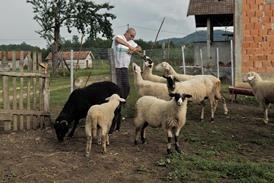Dirs: Agusti Villaronga, Lydia Zimmermann, Isaac P Racine. Sp-Mex. 2002. 96mins.
Aro Tolbukhin: In The Mind Of A Killer is a profoundly spooky, startlingly original contribution to the cinema's enduring fascination with serial murderers. This intricate, multi-layered false documentary based on a notorious real-life case is by no stretch of the imagination a genre film, and commercial prospects are circumscribed by its disturbing subject and semi-experimental form. However the undeniably compelling quality should make this a talking-point at festivals and a strong contender for small-scale arthouse exposure.
The film weaves a web of documentary and fictional material shot at different times and on different formats. Its starting point is a 1981 French television interview with Tolbukhin, a 42 year-old Hungarian merchant seaman whose life was saved by a Guatemalan mission hospital where he turned up ill and emaciated. He repaid the favour by burning alive seven people, including children and pregnant women.
After his arrest, Tolbukhin made no effort to explain himself. "I just did it," he said flatly. He also claimed to have murdered another 17 women, all pregnant, though the subsequent judicial enquiry cast doubt on his confession.
Intrigued, the French team talked to people who knew Tolbukhin, including his Hungarian nursemaid and a nun from the mission, as well as securing a more extended interview with the prisoner himself before he was executed in 1982. Their footage, shot on 16mm, together with some amateur Super-8mm film, languished unseen in the production company's vaults.
Fifteen years later, Lydia Zimmerman, one of the directors of the present project, came across this archive footage and acquired the rights. With Agusti Villaronga and Isaac P Racine, she conducted further interviews with mission workers. They declare themselves puzzled by the contrast between the "gentle and compassionate man" who first arrived there and the cold-blooded killer he seemed later to become. The directors also shot dramatised scenes reconstructing his tormented relationship with one of the nuns.
The boldest stroke is an extended fictional segment exploring Tolbikhin's past. We learn how Aro and his sister, twin children of a severe doctor, never knew their sick mother, communicating with her only by letter until they sneaked into her room and discovered an empty dress laid out on the bed. That's just the beginning of a traumatic childhood which also involved an incestuous pregnancy and a terrible death by burning.
Shot in stylised 35mm black-and-white and announced with its own silent movie-style title card, this chapter, which begins around the hour mark, dominates the film's second half. Virtually a stand-alone mini-feature in its own right, it is steeped in the eerie mood of a Gothic thriller and fulfils the directors' promise to plunge the viewer deep inside Tolbukhin's mind.
With its varied visual textures and contradictory evidence, the film reflects on the elusive nature of truth, the dehumanising impact of war (although the Guatemalan sequences had to be shot for practical reasons in Mexico) and the nature of guilt, finally leaving it open whether Tolbukhin was an evil psychopath or a tragic victim of circumstance.
Prod cos: Oberon Cinematografica, Altavista Films
Int'l sales: Grupo Pi
Exec prods: Antonio Chavarrias, Francisco Gonzalez Compean, Monica Lozano
Prods: Chavarrias, Gustavo Montiel Pages
Scr: Agusti Villaronga, Lydia Zimmermann, Isaac P Racine
Cinematography: Guillermo Granillo
Prod des: Margalida Obrador, Lorenza Manrique
Ed: Ernest Blasi
Music: Jose Manuel Pagan
Main cast: Daniel Gimenez Cacho, Carmen Beato, Zoltan Jozan, Mariona Castillo, Aram Gonzalez


















No comments yet